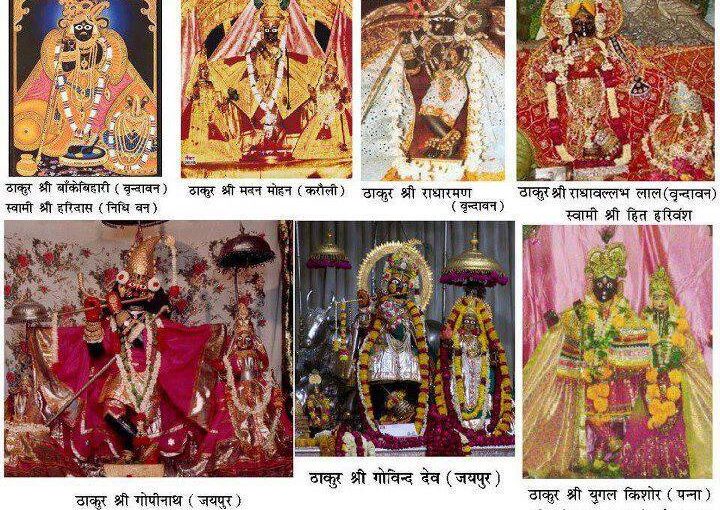The spat thakurs (seven thakurs) of Vrindavan are seven ancient vigraha (Statue) of lord Krishna. Some of them are self manifested while others are quite ancient (5000+ years old). Before Mughal era, all seven Thakurs used to reside in Vrindavan but during period of Aurangajeb, a cruel mughal (Islamic) emperor, some of these thakurs were shifted to Jaipur for safety by warrior Rajputs and now they reside there which is in the Indian state of Rajasthan. Rajupt’s are warrior clan based out of today’s Indian state of Rajasthan who fought multiple wars with Mughals.
Vrindavan is a city of temples and there are 5000+ temples in the city. Vrindavan is the city of Lord Krishna where he spent all his childhood and till the time he left for Mathura. Nandbaba shifted to Vrindavan when Kansa started giving too much trouble to the residents of Gokul.
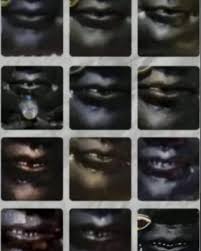
The sapt thakurs are very famous and Devotees love them very much. Sevak (priests) in these Thakur have seen their various leelas (miracles) which may be difficult to believe for some peoples. For example The thakur Radha Raman is famous for his Dant leela and devotees can see his body in different positions at different times of the day. You can visit him today at famous Radha raman temple.
Similarly Banke bihari is known as as Rasiya (Romantic) Thakur. The curtain is rolled frequently in front of him so that he don’t fall in love with any of devotees and go with them. Folklore says that once priest forget to roll the curtain; meanwhile he fell in love with one of devotee and started to walk away to her. Swami Haridas Ji even wrote a pad: “Ta Thakur Ki Thakurain” (even though Shri Krishna is the main controller, Shri Radha Rani controls him).
The sapt Thakurs
The seven Thakurs of Vrindavan are Radha raman ji, Banke bihari ji, Radha vallabha ji, Jugal Kishor ji, Govind dev ji, Govind dev ji, Madan Mohan ji and Gopinath ji. During the time of Mughal emperor Aurangajzeb, the safety of these Thakurs was in great danger and he was out to destroy Hindu temples. These thakurs was hidden and some of them were shifted out of Vrindavan and never returned.
Radha raman ji

Gopala Bhatta Gosvami used to serve and worship Shaligrama. Once, a rich man came to Vrindavan. He wanted to give clothes and jewelry for Gopala Bhatta’s Shaligramas. But Gopala Bhatta could not use them because his Shaligramas were round. He told the man to give the decorations to someone else. However, the man did not want to take them back. So, Gopala Bhatta kept the clothes and jewelry with his shilas.
Next day after morning bath he found out that one of Shaligramas had manifested into Radha raman, the beautiful three-fold bending form of Tri-Bhangananda-Krishna. The fire used in Kitechen in burning from 500+ years. He now resides in Radha raman temple, vridavan.
Banke bihari ji
Swami Haridas was a great devotee of lord Krishna. Because of his musical prayers, Radha and Krishna themselves appeared before him. Then, Swami Haridas asked them to become one form. At his request both merged into one and formed statue of Bankey Bihari. You can now a days see him in Banke bihari temple, Vrindavan.
Devotees also know him as Rasiya (Romantic) Thakur. The curtain is rolled frequently in front of him so that he don’t fall in love with any of devotees and go with them. Folklore says that once priest forget to roll the curtain; meanwhile he fell in love with one of devotee and started to walk away to her. Swami Haridas Ji even wrote a pad: “Ta Thakur Ki Thakurain” (even though Shri Krishna is the main controller, Shri Radha Rani controls him).
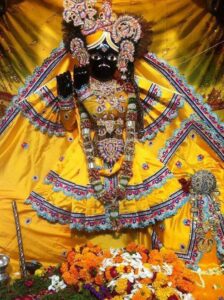
Radha vallabha ji

A long time ago, the one of ancestor of Atmadeva Brahman prayed to Lord Shiva at Mount Kailash. Lord Shiva became very happy with his prayers and as a boon he manifested the Vigraha (statue) of Radha vallabha ji and gave to him.
Later Hit Harivansh Ji received it from Atmadeva Brahman as a marriage gift. He braught Rasha vallabha ji to Vrindavan. At first, Shri Radha Vallabh Ji stayed in Madan Teira. After that, he was moved to Sewa Kunj. Later, when Radha vallabha temple, Vrindavan was built, Shri Radha Vallabh Ji has been staying here ever since.
Jugal Kishor ji
The thakur now a days reside in Panna in Madhya Pradesh.
The idol of Jugal Kishore Ji was found by Hariram Ji in Kishorvan of Vrindavan. He was installed there, later the king of Orchha built a grand temple there. Years later, when the temples of Vrindavan were being demolished during the reign of Aurangzeb, the devotees took Jugal Kishore Ji to Panna (Madhya Pradesh) near Orchha. Since then he reside in Jugal Kishore temple of Panna.
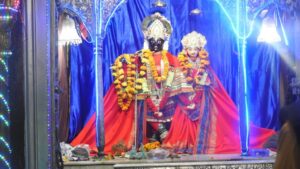
Govind dev ji
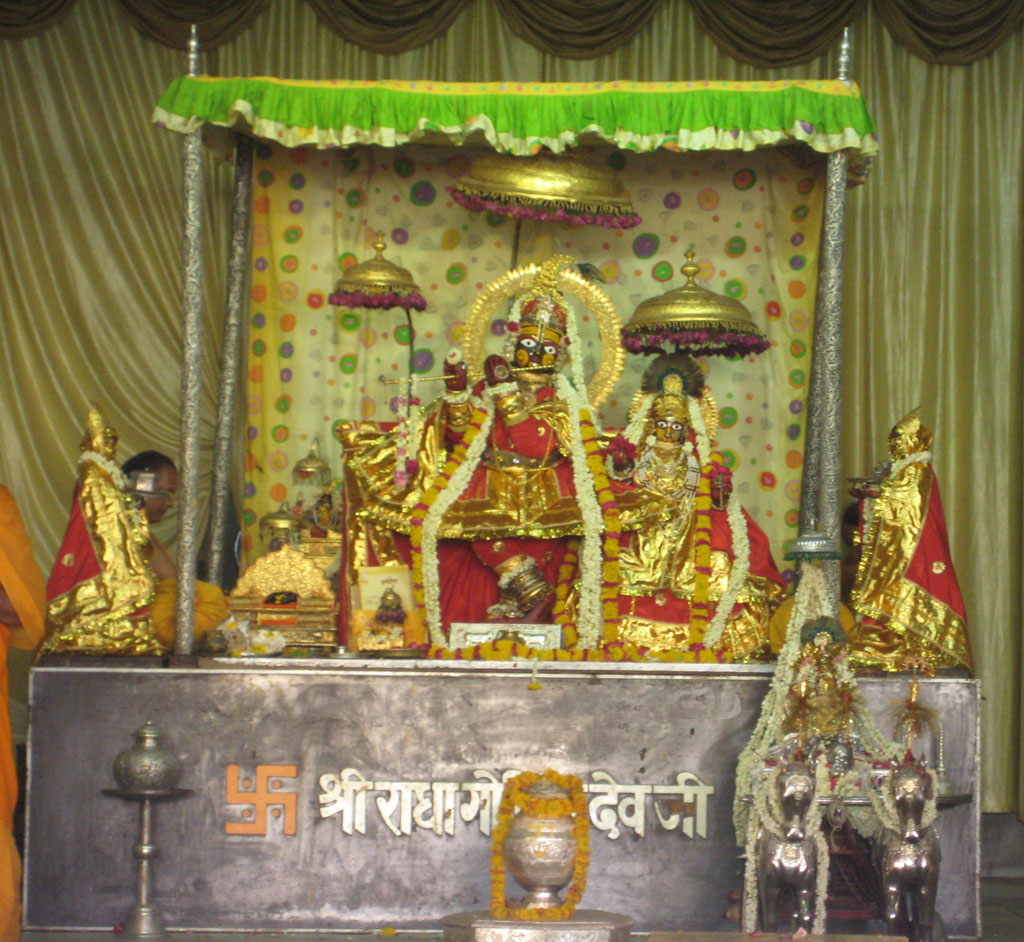
Vrajanabha, Lord Krishna’s great-grandson, installed the original Govind dev ji Deity in Vrindavan over five-thousand years ago. Further, around five hundred years ago, Shri Rupa Goswami discovered the deity of Lord Govinda buried in the ground at the site where the majestic temple of Govindaji in vrindavan now stands.
Raja Mansingh of Omer built a grand temple of Govind Dev Ji in Vrindavan, where Govind Dev Ji resided for 80 years. But when Braj Dham was attacked during the reign of Aurangzeb, the devotees of Govind Dev Ji took him to Jaipur. Since then Govind Dev Ji resides in the royal temple of Jaipur.
Madan Mohan ji
Madan Mohan ji used to reside in Madan mohan temple in Vrindavan. Construction began in 1500 and Sanatan Goswami was the one who carefully watched over the building of the Temple.
In 1670 AD, the Mughal emperor Aurangzeb attacked Vrindavan. At that time, King Jai Singh wanted to keep the original statue of Madan Mohan safe. So, he secretly moved it to Jaipur during the night. This was before Aurangzeb attacked the temples in Vrindavan and Mathura. Later, King Gopal Singh moved these holy statues to Karauli. Now, the real statues of the Shri Radha Madan Mohan temple is in the Madan Mohan temple in Karauli, Rajasthan. Then, in 1748 AD, people made a replica of the original statue. This replica was put in the Madan Mohan temple in Vrindavan.
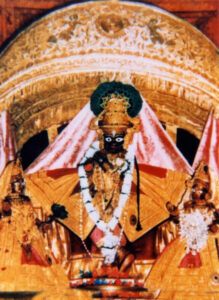
Gopinath ji
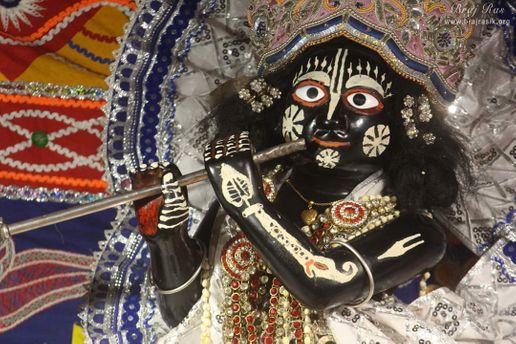
Vrajanabha, Lord Krishna’s great-grandson, installed the original Gopinath dev ji Deity in Vrindavan over five-thousand years ago. Further, Around five hundred years ago, Paramananda Bhattacharya found the statue of God in the ground at Banshivat, near the Yamuna River. The deity was the worshipped in Gopinath temple, vrindavan.
Later, when Braj Dham was attacked during the reign of Aurangzeb, the devotees of Govind Dev Ji took him to Jaipur. Since then Govind Dev Ji resides in the a temple in Jaipur.

